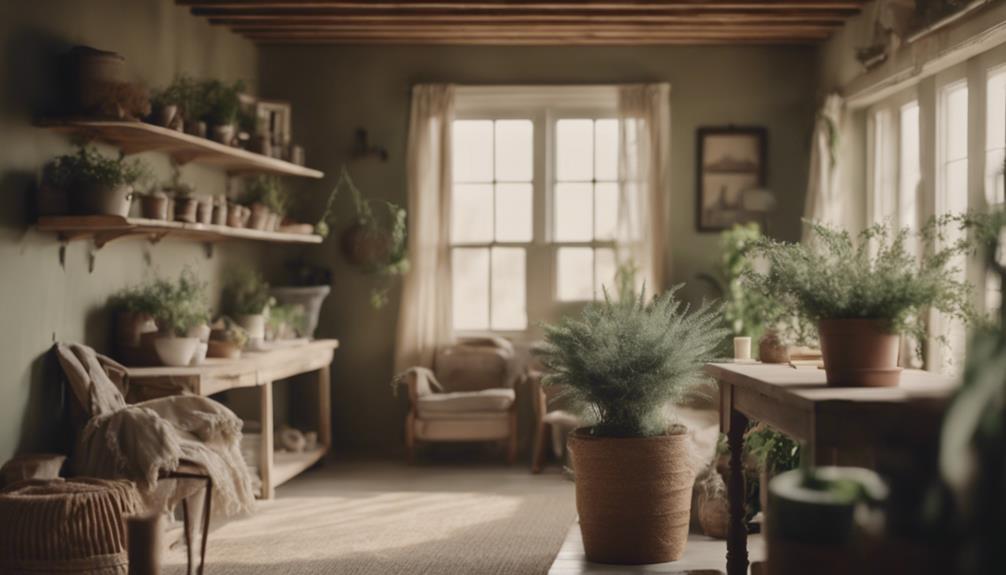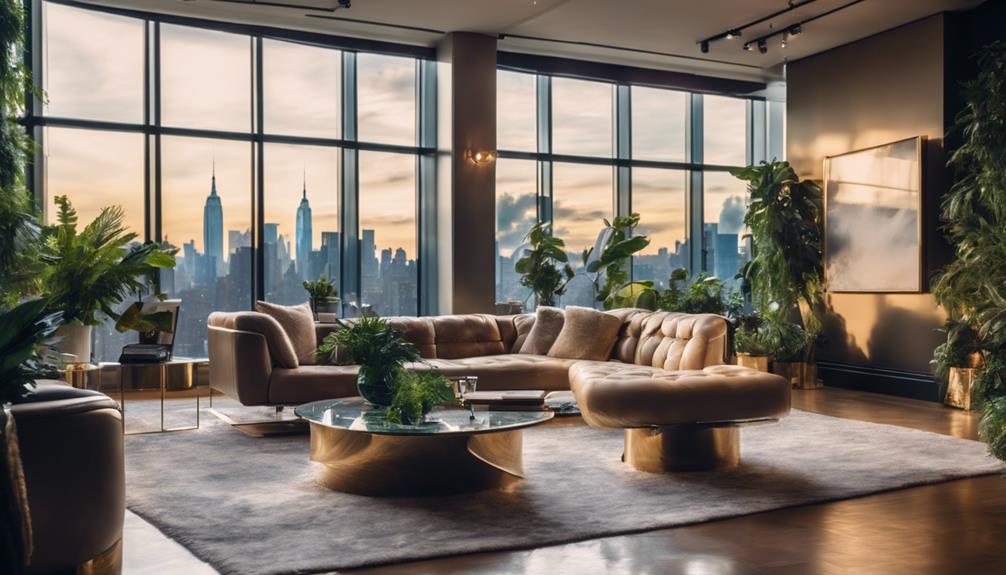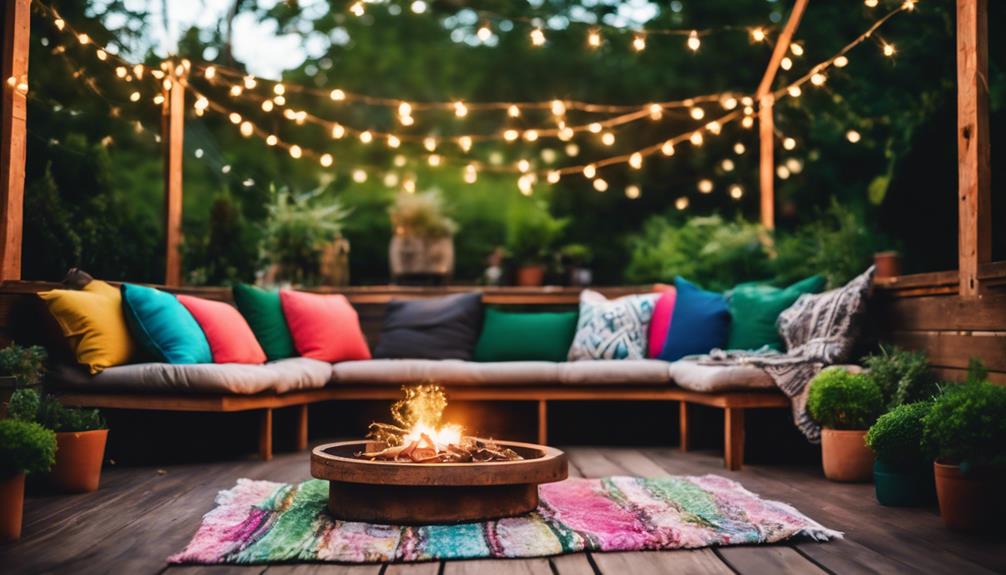Choosing the perfect farmhouse paint colors can instantly create a warm and inviting atmosphere in your home. Opt for gentle neutrals like Sherwin-Williams Alabaster or Behr Silver Drop to enhance natural light and coziness. Pair these with earthy greens such as Sea Salt for a peaceful vibe. For a bold touch, consider deeper shades like charcoal or rich burgundy. Mixing these colors thoughtfully will help to create a welcoming ambiance for gatherings. Don’t forget to consider seasonal shades to keep things fresh throughout the year. If you’re curious about how to make these colors work best in your space, there is plenty more to explore! Looking to complement your farmhouse paint colors with the perfect decor? Check out farmhouse rug options to bring the room together. A natural jute rug adds texture and a rustic feel, while a vintage Persian rug can add character and charm. These farmhouse rug options will enhance your color scheme and help create a cohesive and inviting atmosphere in your home.
Key Takeaways
- Choose soft, warm whites and greige hues to create a cozy backdrop that complements natural wood accents.
- Incorporate calming shades like sage green and muted blues for a tranquil atmosphere in living spaces.
- Use darker, dramatic colors like charcoal and deep greens to add depth and sophistication to well-lit areas.
- Strategically apply bold accent colors against neutral palettes to reflect personal style and enhance visual interest.
Popular Modern Farmhouse Colors
When choosing popular modern farmhouse colors, you'll find that shades like Sherwin-Williams Alabaster and Behr Silver Drop create inviting and versatile spaces.
Alabaster, a soft off-white with subtle greige undertones, is perfect for walls, trim, and cabinetry. It pairs beautifully with both warm and cool accent colors, making your farmhouse feel cozy yet stylish.
Behr Silver Drop, a warm gray, enhances the atmosphere by reflecting light while maintaining a comforting vibe. Its Light Reflectance Value (LRV) of 70 means it brightens up your rooms without overwhelming them.
If you're looking for something with a hint of color, consider Sherwin-Williams Sea Salt. This soft green-gray shade brings a calming effect to any space, appearing almost blue in certain lighting, which adds depth to your farmhouse design.
For those who prefer a clean, bright look, you can't go wrong with Benjamin Moore Simply White. With an LRV of around 91.7, it offers a striking contrast to natural wood tones and emphasizes the modern farmhouse aesthetic.
These colors not only complement each other but also create a warm, inviting home.
Choosing the Right Paint
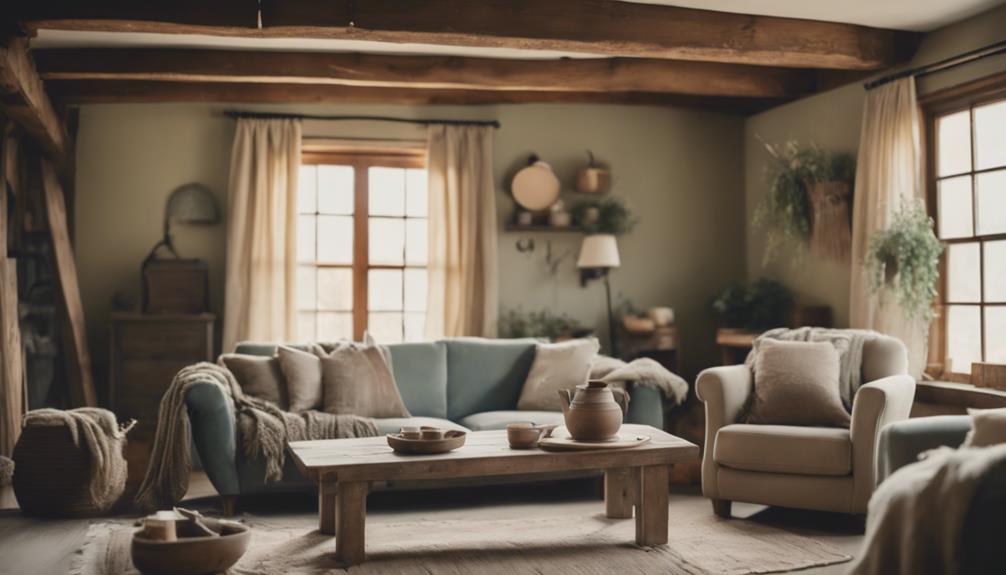
Choosing the right paint for your farmhouse involves considering how natural light influences color perception throughout the day. The way light interacts with colors can dramatically change their appearance, so it's crucial to test your options under various lighting conditions.
Here are three tips to help you make the best choice:
- Test Samples: Paint swatches directly on your walls and observe how they look at different times of the day to find the best fit for your space.
- Light Reflectance Value (LRV): Pay attention to LRV. Lighter colors with higher LRVs can open up a space, while darker tones often create a cozy, intimate feel.
- Neutral Palette Balance: For a cohesive look, combine warm whites with greige hues. This balance can enhance your farmhouse's inviting atmosphere.
Application Techniques for Paint
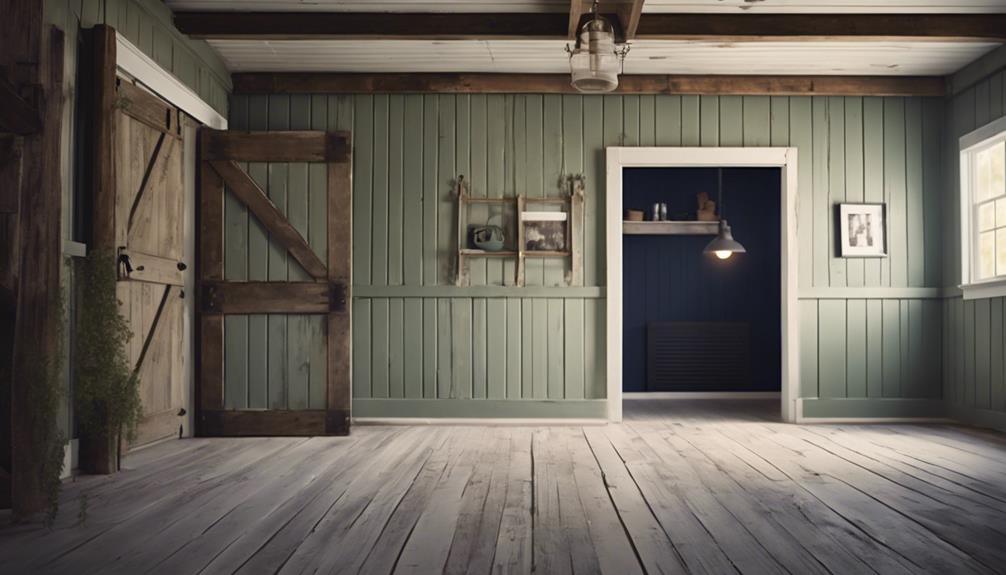
After selecting the perfect paint colors for your farmhouse, mastering application techniques guarantees a professional-looking finish that enhances your home's charm.
Start with proper surface preparation; clean your walls with a mild detergent and sand the surfaces to improve paint adhesion. This step is essential for achieving a smooth, long-lasting finish.
Next, apply a high-quality primer, especially on challenging surfaces like vinyl or previously painted walls. This creates a uniform base, enhancing your paint's color vibrancy.
When it comes time to paint, use specific application techniques for paint. Employ the cut-in method for edges and an 'M/W' pattern when rolling walls to secure even coverage and minimize streaks.
Don't forget to test paint samples on the wall first. Colors can shift dramatically in different lighting, so this step helps you choose the right shade.
Finally, allow adequate drying time between coats—typically 2-4 hours for latex paints—to prevent peeling and secure a durable finish.
With these techniques in hand, you'll transform your farmhouse into a cozy and inviting space.
Understanding Color Psychology
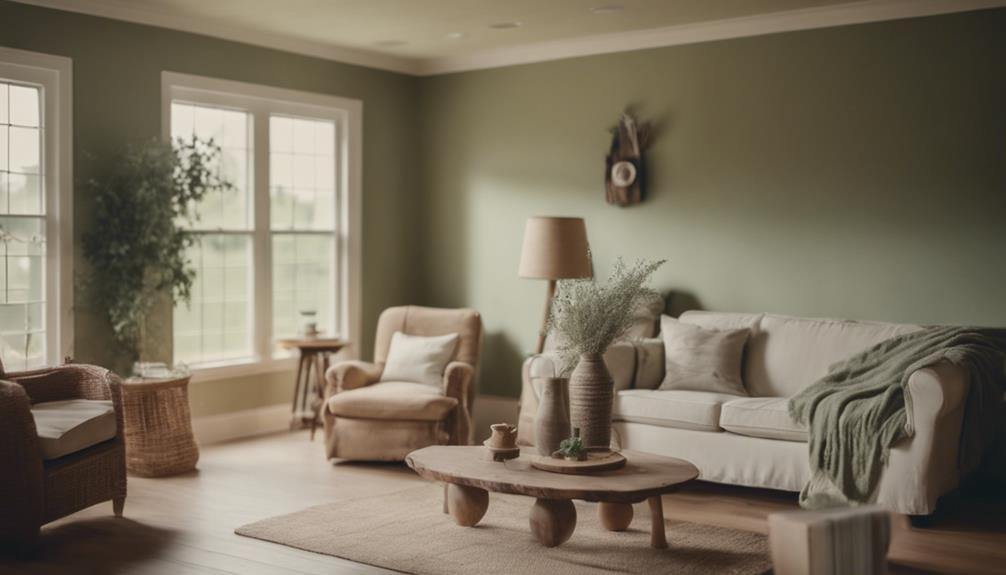
When choosing paint colors for your farmhouse, consider how different shades can impact your mood.
Warm tones can wrap your space in nostalgia and comfort, while calming neutrals create a serene atmosphere.
Understanding this emotional influence helps you craft a home that feels just right for you.
Emotional Impact of Colors
Colors in your farmhouse can evoke powerful emotions, shaping the ambiance and mood of each room. By understanding color psychology, you can create spaces that feel warm, inviting, and rejuvenating. Here are three key aspects to contemplate:
- Warm Tones: Incorporating muted reds and earthy browns can foster feelings of nostalgia and coziness. These colors work wonders in common areas like the kitchen and living room, making them feel more inviting.
- Earthy Greens: Shades like Sherwin-Williams Pewter Green bring a touch of nature indoors. This color not only enhances tranquility but also promotes rejuvenation, perfect for spaces where you unwind, such as the bedroom or a reading nook.
- Bold Accents: Deep blues or blacks can energize your space without being overwhelming. Use them strategically as focal points to create dynamic areas that balance warmth and vibrancy.
Calming Neutrals Vs. Warm Tones
Choosing between calming neutrals and warm tones can greatly influence the atmosphere of your farmhouse, setting the stage for comfort and relaxation.
Calming neutrals, like soft whites and greiges, create serene spaces that promote tranquility and a sense of openness. They're perfect for modern farmhouse designs where you want to feel at ease.
On the other hand, warm tones, such as muted reds and earthy browns, evoke a sense of nostalgia and coziness. These colors work wonders in intimate areas like living rooms and kitchens, making them feel inviting and snug.
Color psychology supports these choices; calming neutrals enhance balance, while warm tones stimulate emotional warmth. You might also consider incorporating earthy greens, such as sage, to connect your interior with nature. This not only adds a revitalizing touch but also fosters a rejuvenating environment that promotes well-being.
Ultimately, blending calming neutrals with warm tones can create a balanced aesthetic in your farmhouse. This combination brings depth and interest, while still maintaining a cohesive and inviting style that welcomes you and your guests.
Classic and Neutral Shades
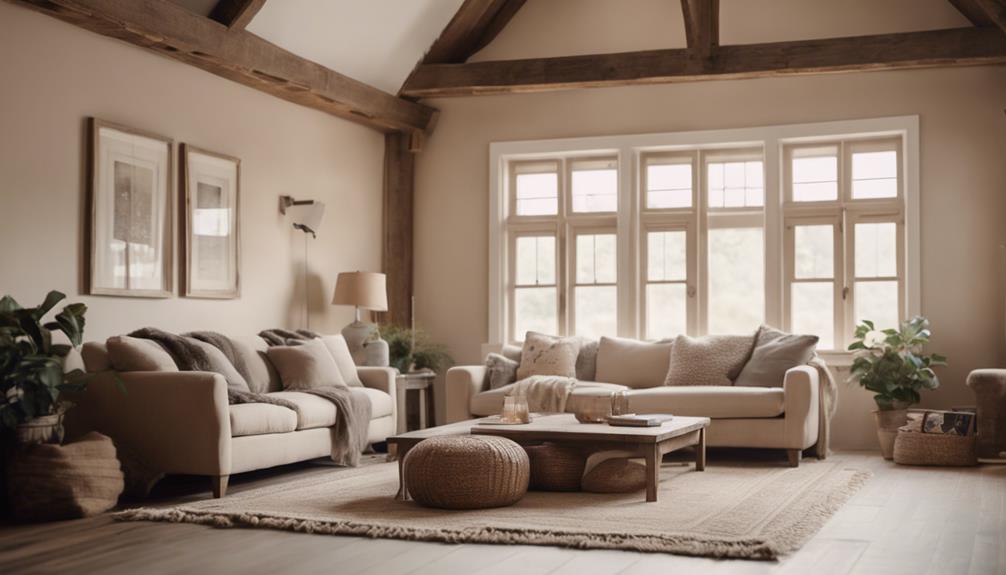
Classic and neutral shades form the foundation of a timeless farmhouse aesthetic, effortlessly blending warmth with a fresh, inviting atmosphere. When you choose the right colors, you create a cozy atmosphere that makes your home feel welcoming.
Here are three classic options to take into account:
- Warm Whites: Shades like Decorators White and Alabaster offer a crisp yet soft backdrop, perfect for highlighting natural wood accents and vibrant decor elements.
- Creamy Whites: These shades add tranquility and warmth, making them incredibly versatile and ideal for any room in your farmhouse.
- Greige Hues: A perfect blend of gray and beige, greige provides a cozy atmosphere while complementing various decor styles, enhancing the overall charm of your space.
Incorporating classic neutrals like soft beiges and warm whites allows you to create a serene environment that encourages bold accent colors.
This strategic use of classic and neutral shades not only elevates your farmhouse decor but also invites comfort and style into your home, making it the perfect sanctuary for family and friends.
Cozy and Dramatic Hues
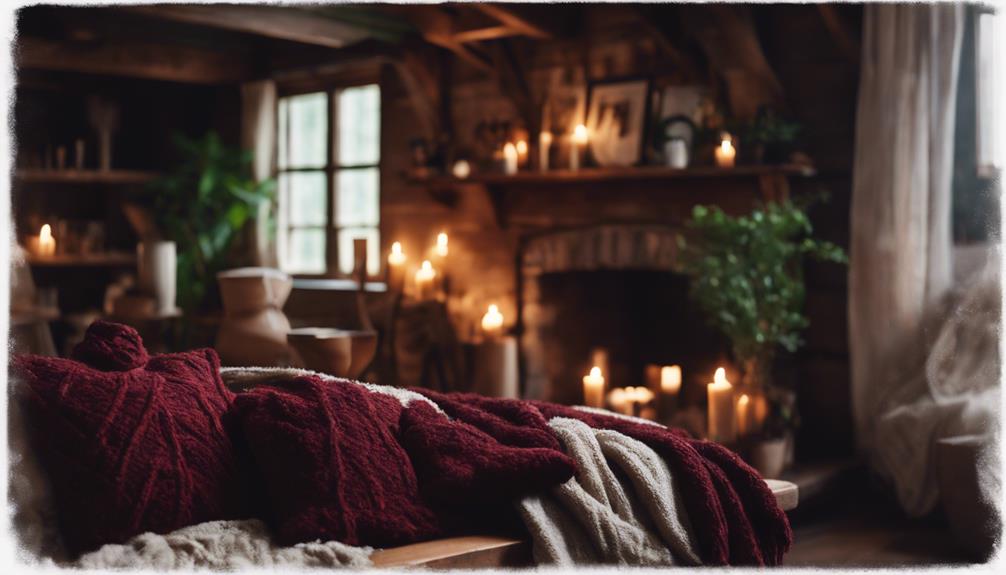
Embracing cozy and dramatic hues can transform your farmhouse into a warm, inviting retreat that balances comfort with striking sophistication. By incorporating lower-value colors like charcoal and deep greens, you create a moody atmosphere that enhances warmth in your living areas.
These dramatic colors, such as Andes Summit from Benjamin Moore or Gunmetal Gray from PPG, work beautifully in well-lit spaces, allowing the richness of the hues to shine while keeping the farmhouse aesthetic intact.
Using dark, moody shades adds depth and sophistication, providing a striking contrast to lighter elements in your decor.
For a more understated touch, consider incorporating sage green tones like Treron from Farrow & Ball. This shade offers a unique personality while remaining elegant and cozy.
Light sage shades, such as Whitened Sage from Behr, also bring muted elegance, enhancing the inviting atmosphere in kitchens and living spaces.
Unique and Bold Color Choices
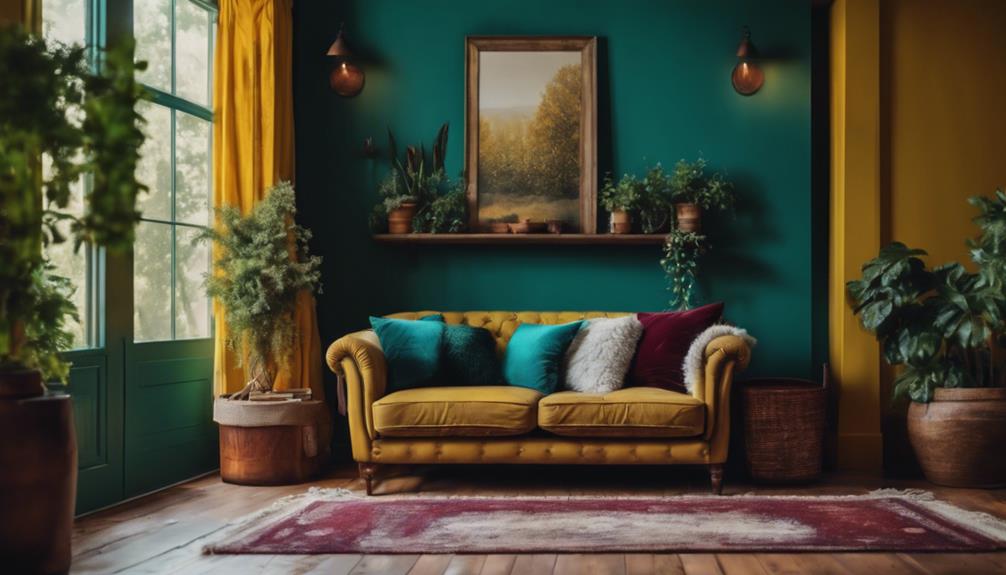
When you think about unique and bold color choices, consider how striking patterns and vibrant hues can transform your farmhouse.
Bold patterns like buffalo plaid can add character, while colors like Hale Navy make excellent accent options.
Bold Pattern Ideas
How can you transform your space with bold patterns that capture the essence of modern farmhouse style?
By integrating unique and striking designs, you can create inviting environments that reflect your personality. Here are three bold pattern ideas to inspire your farmhouse decor:
- Buffalo Plaid: This classic pattern adds character and charm. Use it in throw pillows or area rugs to create focal points in smaller spaces.
- Striking Plaid with Hale Navy: Consider using Hale Navy for your bold plaid patterns. It enhances your decor without overwhelming the overall aesthetic, especially when paired with warm taupe shades.
- Bright White Walls: Start with bright white walls to allow bold patterns to pop. This backdrop not only livens up neutral spaces but also makes your bold trim and paneling hues stand out beautifully.
Striking Color Combinations
Striking color combinations can transform your farmhouse into a vibrant reflection of your style, making each room feel uniquely inviting.
Start with bright white walls as your canvas; they provide a perfect backdrop for showcasing bold accents. Consider deep grays or rich burgundies for trim, which can add a sophisticated touch that enhances your farmhouse's charm.
For more daring choices, think about using Forest Green for an accent wall or doorway. This color bridges modern and traditional styles, creating a stunning focal point without overwhelming the space. Pair it with warm taupe shades to cultivate a cozy, rustic ambiance, especially when complemented by natural wood accents.
Additionally, don't shy away from adding a single pop of vibrant color. Benjamin Moore's Irish Clover can serve as a playful accent, punctuating your mixed finishes and furniture styles.
When combining these striking colors, remember to balance them with lighter tones. For example, using Hale Navy against lighter backgrounds can create a striking contrast that adds character to small spaces.
Suggested Color Combinations
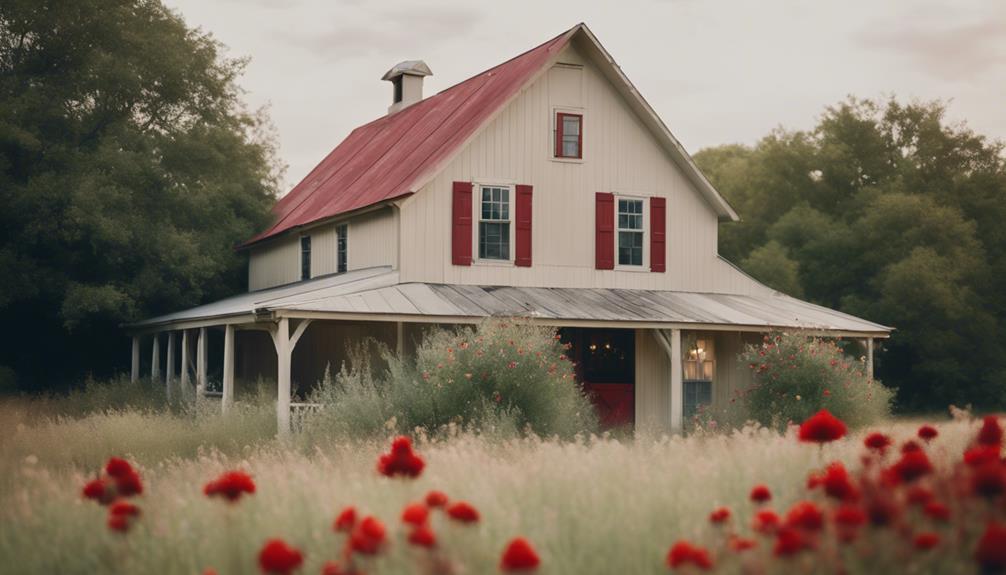
Explore a variety of suggested color combinations that effortlessly blend rustic charm with modern sophistication in your farmhouse decor.
These farmhouse colors can create a cozy atmosphere, making your home feel inviting and warm. Here are three combinations to reflect upon:
- Benjamin Moore Revere Pewter & Sherwin-Williams Iron Ore: This pairing offers a sophisticated contrast that enhances rustic charm while keeping the space cozy.
- Sherwin-Williams Sea Salt & Benjamin Moore Simply White: For a serene and inviting look, this light and airy combination brightens your rooms, making them feel open and revitalizing.
- Behr Silver Drop & Soft Greens: Using Silver Drop as a base with accents of Sherwin-Williams Sea Salt creates a harmonious blend, evoking a calm, cozy vibe perfect for relaxation.
Seasonal Color Trends

Seasonal color trends in farmhouse decor transform your space, reflecting nature's mood and inviting warmth throughout the year.
In fall, you can embrace warm tones like burnt orange and deep red, which create a cozy atmosphere perfect for gatherings.
As spring arrives, consider incorporating soft blues and greens such as sage or robin's egg blue. These revitalizing shades uplift your interiors and harmonize beautifully with floral accents.
Summer invites you to experiment with earthy colors like terracotta and muted yellows, which resonate with the vibrant outdoor environment, enhancing your farmhouse's rustic charm.
When winter sets in, lean towards crisp whites and cool grays that foster a serene and cozy atmosphere, mirroring the tranquility of the season.
Tips for Testing Paint Colors
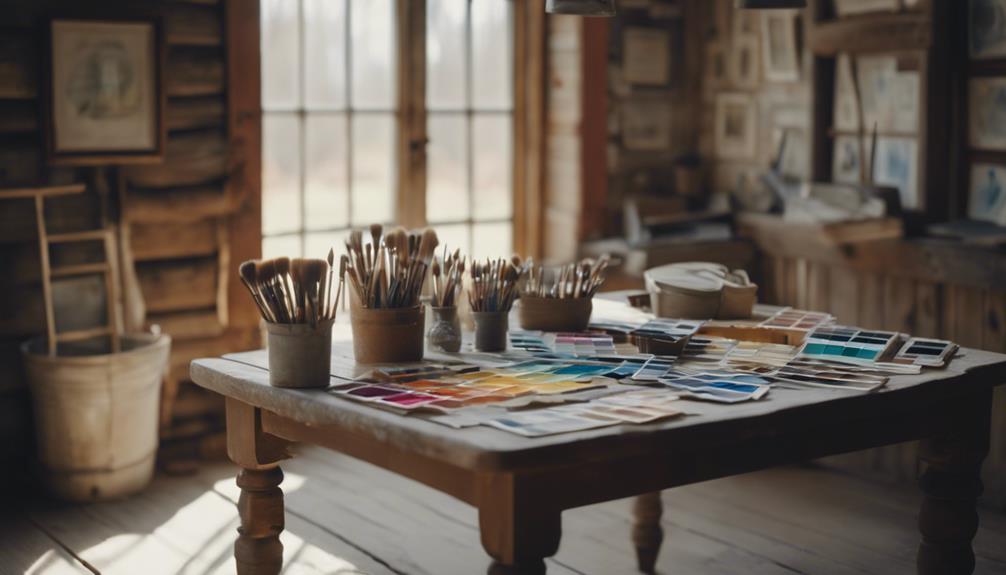
When testing paint colors, it's crucial to apply samples on large swatches or directly on the wall to see how they interact with your room's lighting and decor. This hands-on approach helps you accurately observe paint color in various settings.
Here are three tips to make the most of your testing process:
- Sample at Different Times: Observe paint color at various times of the day. Natural and artificial light can dramatically change how a color looks, so check it in the morning, afternoon, and evening.
- Try Various Finishes: Use multiple paint samples of the same color in different finishes—matte, satin, and gloss. This will help you determine which finish best suits your desired look and the room's functionality.
- Keep a Color Journal: Document your thoughts in a color journal. Jot down how each sample looks alongside your furniture and decor, which will aid in your final decision-making process.
Frequently Asked Questions
How Do You Make a Farmhouse Cozy?
To make a farmhouse cozy, you should incorporate warm neutrals and soft colors. Layer textures with blankets and rugs, add earthy tones in decor, and maximize natural light for a welcoming, inviting atmosphere.
What Color Makes You Feel Cozy?
Like a warm hug on a chilly day, earthy browns and soft neutrals make you feel cozy. These colors wrap your space in comfort, inviting you to relax and enjoy the soothing atmosphere they create.
What Colours Make a Room Cozy?
To make a room cozy, opt for warm neutrals like greige and cream. Earthy tones, deep grays, and soft textures enhance the inviting feel, while accent colors like barn red add warmth and character.
What Color Walls Look Best in a Farmhouse?
"Beauty is in the eye of the beholder." For a farmhouse, soft whites and warm grays create an inviting backdrop, while earthy greens add tranquility. Choose colors that resonate with you for the best results.
Conclusion
Incorporating the right farmhouse paint colors can truly transform your space into a cozy haven.
Whether you opt for classic neutrals or decide to go bold, remember to embrace your personal style—after all, you're not living in the Victorian era!
Don't forget to test your colors in different lighting to find the perfect hue.
With these tips, you're well on your way to creating a warm and inviting atmosphere that feels just like home.
